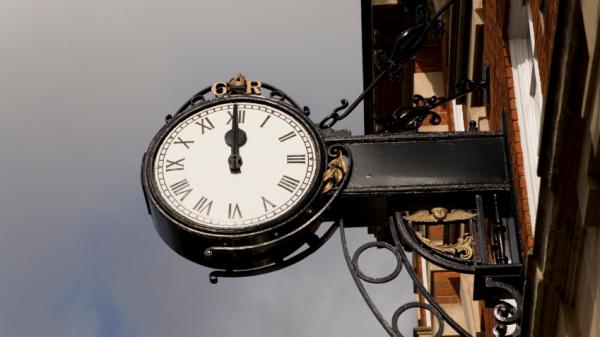What Do AM and PM Stand For?
Some countries, including the US, Canada, and Australia, use the 12-hour clock format including am and pm. What do these abbreviations mean? Is midnight am or pm?

12-hour clock at noon: 12 am or 12 pm?
©iStockphoto.com/Gordon Dixon
Two 12-Hour Periods
The 12-hour system divides the 24 hours of a day into two periods lasting 12 hours each. The first 12-hour period is designated as am. It runs from midnight to noon. The second period, marked pm, covers the 12 hours from noon to midnight.
The abbreviations am and pm derive from Latin:
- AM = Ante meridiem: Before noon
- PM = Post meridiem: After noon
Using numbers from 1 to 12, followed by am or pm, the 12-hour clock system identifies all 24 hours of the day. For example, 5 am is early in the morning, and 5 pm is late in the afternoon; 1 am is one hour after midnight, while 11 pm is one hour before midnight.
Ante meridiem is commonly denoted as AM, am, a.m., or A.M.; post meridiem is usually abbreviated PM, pm, p.m., or P.M. Like many other sources, timeanddate.com uses am and pm, but the other variants are equally correct and widely used.
Midnight and Noon: AM or PM?
The main weakness of the 12-hour system is a widespread confusion about which abbreviation should be used for noon and midnight: neither moment can logically be identified as before noon (am) or after noon (pm). For example, the moment of midnight occurs precisely 12 hours after noon on the previous day and 12 hours before noon on the following day.
However, most digital clocks and most sources, including timeanddate.com, designate midnight as 12 am and noon as 12 pm. Although the precise moment of noon falls in neither category, the hour succeeding it, from 12:00:01 to 12:59:59, is clearly after noon.
To avoid any confusion when referring to the precise moment of noon or midnight, we recommend using the designations 12 noon and 12 midnight instead.
Tips for better teamwork across time zones
Midnight Confusion
Another source of confusion is the lack of a date designator in the 12-hour system, making it impossible to logically identify a correct moment in time when only a date and 12:00 am (midnight) is provided.
Imagine being asked to pick up a friend at the airport at 12:00 am on April 13. Would you go there at midnight between April 12 and April 13? Or 24 hours later?
One way to overcome this problem is to sacrifice accuracy for clarity. Your friend could ask you to be at the airport at 12:01 am on April 13 or, if the following midnight is meant, at 11:59 pm on April 13. Alternatively, the 24-hour format could be used. Here, 0:00 refers to midnight at the beginning of the day while 24:00 is midnight at the end of the day.
Time Formats
| 12-hour | 24-hour |
|---|---|
| 12:00 (midnight) | 0:00 (beginning of the day) |
| 12:01 am | 0:01 |
| 1:00 am | 1:00 |
| 2:00 am | 2:00 |
| 3:00 am | 3:00 |
| 4:00 am | 4:00 |
| 5:00 am | 5:00 |
| 6:00 am | 6:00 |
| 7:00 am | 7:00 |
| 8:00 am | 8:00 |
| 9:00 am | 9:00 |
| 10:00 am | 10:00 |
| 11:00 am | 11:00 |
| 12:00 (noon) | 12:00 |
| 12:01 pm | 12:01 |
| 1:00 pm | 13:00 |
| 2:00 pm | 14:00 |
| 3:00 pm | 15:00 |
| 4:00 pm | 16:00 |
| 5:00 pm | 17:00 |
| 6:00 pm | 18:00 |
| 7:00 pm | 19:00 |
| 8:00 pm | 20:00 |
| 9:00 pm | 21:00 |
| 10:00 pm | 22:00 |
| 11:00 pm | 23:00 |
| 12:00 (midnight) | 24:00 (end of the day) |
Converting 12-Hour to 24-Hour Format
A 24-hour clock, sometimes referred to as military time, states the time according to the number of hours that have passed since midnight. Starting at midnight, hours are numbered from 0 to 24, removing the need for designations like am and pm. For example, at 23:00, 23 hours have passed since the beginning of the current day.
To convert am or pm time to the 24-hour format, use these rules:
From midnight to 12:59 am, subtract 12 hours.
12:49 am = 0:49 (12:49 – 12)From 1 am to noon, do nothing.
11:49 am = 11:49From 12:01 pm to 12:59 pm, do nothing.
12:49 pm = 12:49From 1:00 pm to midnight, add 12 hours.
1:49 pm = 13:49 (1:49 + 12)
Here's how to convert time on a 24-hour clock to the 12-hour system:
From 0:00 (midnight) to 0:59, add 12 hours and use am.
0:49 = 12:49 am (0:49 + 12)From 1:00 to 11:59, just add am after the time.
11:49 = 11:49 amFrom 12:00 to 12:59, just add pm after the time.
12:49 = 12:49 pmFrom 13:00 to 0:00, subtract 12 hours and use pm.
13:49 = 1:49 pm (13:49 - 12)
Where Is the 12-Hour Format Used?
Most countries around the world today use the 24-hour system. However, the 12-hour format, including am and pm, is officially used in a number of countries, including the United States, Canada (except Québec), Australia, New Zealand, and the Philippines.
Why Does the Day Have 24 Hours?
The Egyptians are thought to be responsible for dividing the day into 24 equal parts. One account suggests that this custom evolved because the Egyptians commonly used the base 12, counting the 3 joints in their fingers, not including the thumb.